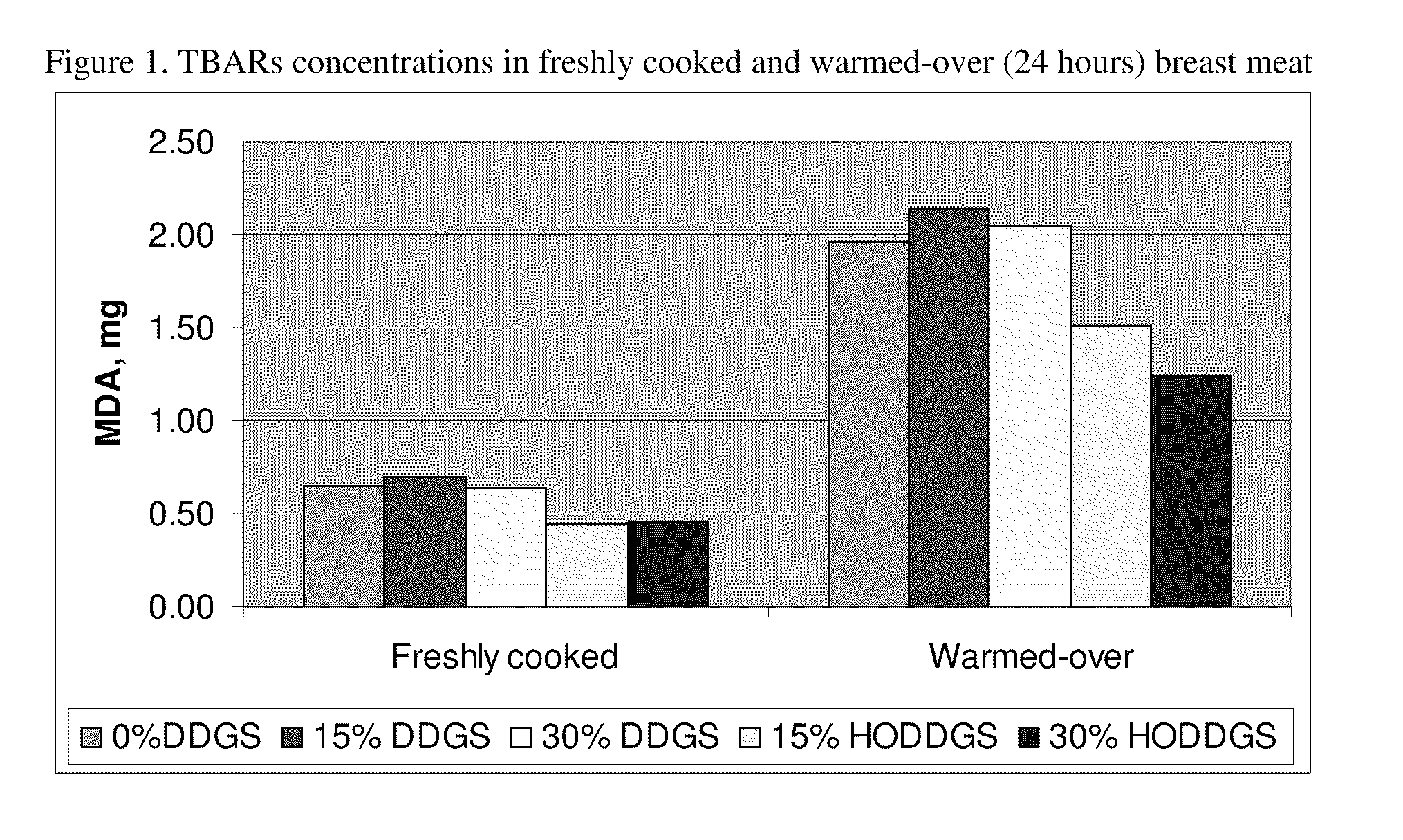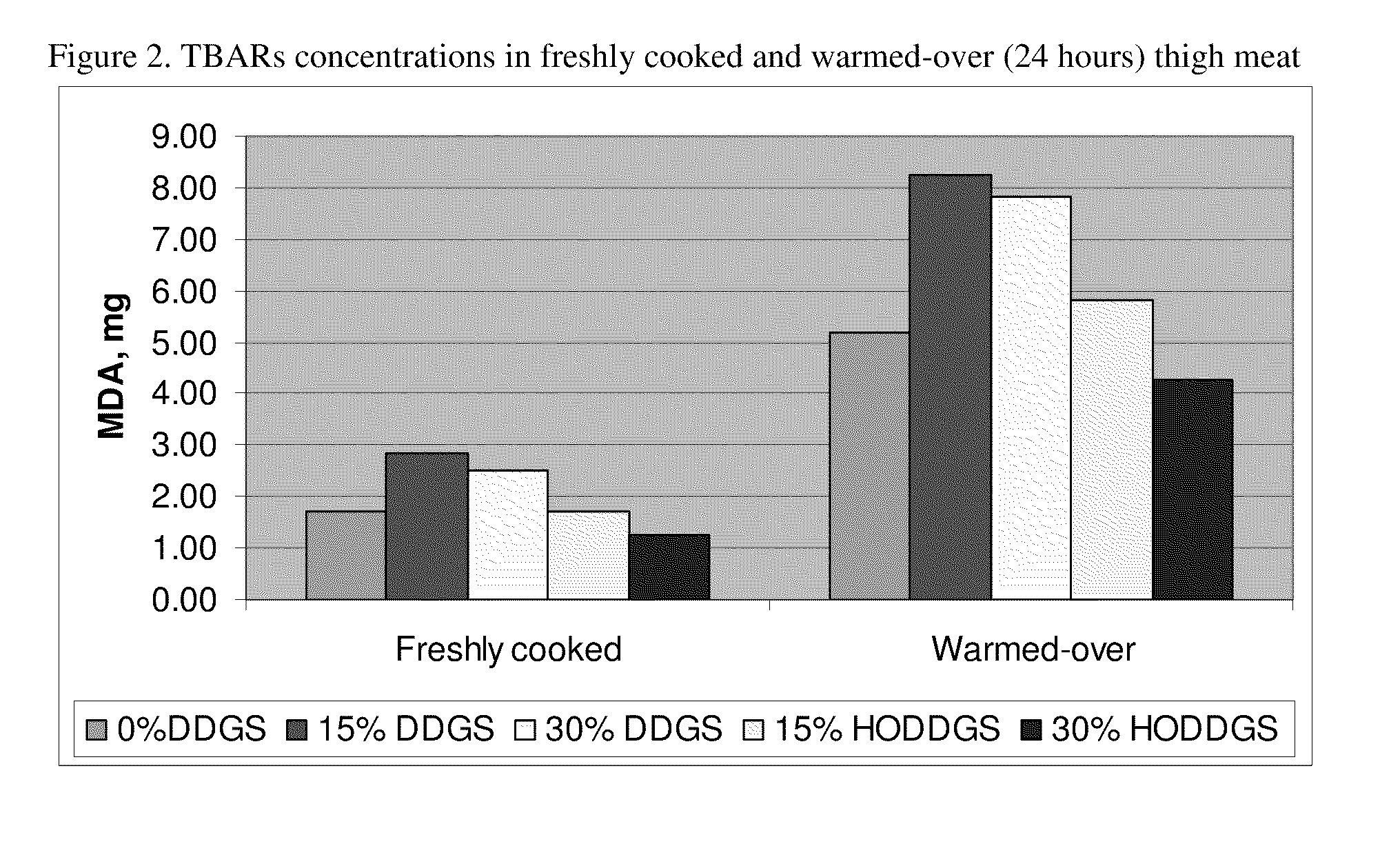Use of High-Oleic Distillers Grains in Animal Feed to Improve Animal Product Quality
- Summary
- Abstract
- Description
- Claims
- Application Information
AI Technical Summary
Problems solved by technology
Method used
Image
Examples
example 1
DDGS Preparation
[0047]Commodity DDGS material was shipped to the TAMU Food Protein Research and Development Center (College Station, Tex.) where it was processed to reduce its oil content. The material underwent hexane extraction at 125° F. for one-hour, followed by air-drying; initial analysis showed a reduction in residual oil content from 10.45% to 1.48%. The extracted DDGS material was shipped back to Pioneer for use in diet preparation. A sample of extracted DDGS, along with basal corn and soybean meal samples, was collected and submitted for determination of moisture, protein, fat (ether extract), gross energy (GE), crude fiber, ash, calcium, phosphorus, and amino acid profile (Table 1). Corn and high-oleic sunflower oil sources were sampled and submitted for GE and fatty acid analyses; a sample of extracted DDGS was also submitted for fatty acid analysis (Table 2).
TABLE 1Analyzed nutrient composition of ingredient sources used to prepare dietsAs-Is-BasisDry Matter BasisCornHO...
example 2
Demonstration that Cooked Meat Derived from Poultry Fed a High-Oleic DDGS Diet Exhibits Improved Oxidative Stability
[0048]Five dietary treatments were prepared using basal corn and soybean meal sources alone (Control, 0% DDGS) or in combination with two levels (15% or 30%) of DDGS with added corn oil (DDGS) or high-oleic sunflower oil (HODDGS). Each oil-DDGS mixture consisted of 91.3% extracted DDGS and 8.7% source oil. A three-phase feeding system was used in this trial: starter (days 0 to 21), grower (days 22 to 35), and finisher (days 36 to 49). Diets were formulated to meet NRC guidelines (9th edition, 1994; Table 3). Treatment diets were manufactured at the Pioneer Livestock Nutrition Center (Polk City, Iowa); ingredient compositions of the complete diets are presented in Table 4. The basal corn source was milled prior to diet preparation to meet an average particle size of 650 to 750 microns. Feed samples of each treatment were collected and submitted for determination of mois...
example 3
Demonstration that Cooked Meat Derived from Cattle Fed a High-Oleic DG Diet Exhibits Improved Oxidative Stability
[0055]Eight yearling Angus steers (approximately 400 kg initial weight) are given free choice access to test diets for a feeding trial lasting 84 days. Steers are fed using a Calan gate system whereby feed access is restricted to a single steer that permits daily feed intake to be measured for each individual steer. Four steers within one pen are fed a control diet containing commodity corn distiller's grain plus solubles (DDGS) whereas the other four steers housed in an adjacent pen in the same barn are fed a test diet containing a mixture simulating the fatty acid composition of HODDGS (DDGS prepared as described in Example 1) that consist of a mixture of 88% fat-extracted distiller's dried corn grain with 12% high-oleic sunflower oil (Table 9). With daily feed intake averaging 10 kg, this requires 6720 kg of feed (including 1344 kg of test product). Feed delivery and r...
PUM
 Login to View More
Login to View More Abstract
Description
Claims
Application Information
 Login to View More
Login to View More - R&D
- Intellectual Property
- Life Sciences
- Materials
- Tech Scout
- Unparalleled Data Quality
- Higher Quality Content
- 60% Fewer Hallucinations
Browse by: Latest US Patents, China's latest patents, Technical Efficacy Thesaurus, Application Domain, Technology Topic, Popular Technical Reports.
© 2025 PatSnap. All rights reserved.Legal|Privacy policy|Modern Slavery Act Transparency Statement|Sitemap|About US| Contact US: help@patsnap.com



